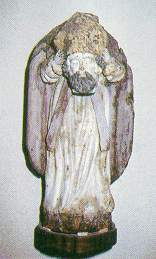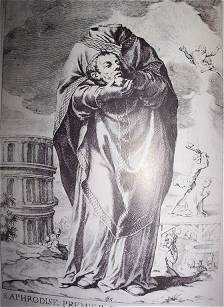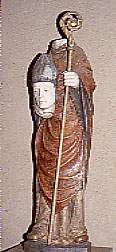SAINT APHRODISE
Watch the video of this page
Please set on the subtitles then use the english automatic translation
This saint is considered as the first bishop of Béziers. The first mention of the sanctuary whose his relics were sheltered is coming from a St Germain-des-Prés two friars' story.
The friars traveled to Spain then settled in Béziers in 858. Many "vitae" (life/legends) have contributed to the current legend. We suppose they are coming from an ancient oral tradition which took place at the Middle-Ages. During the XVIth century - time where the Catholic Church needed to enforce the religious faith - it becomes a single legend (at least in the outlines), considering Saint Aphrodise as a martyr.
However, according to the "Bréviaire de Béziers" (Béziers breviary), during the XIVth and XVth centuries, he was presented as bishop and confessor, quietly died a day of mars, the 22th.
So, it's only at the XVIth century that a new kind of legend appears and his beheading - as his 3 disciples' one - is related. At the same period and for the first time the legend is talking about his loyal camel. His execution date is now settled on april the 22th and his relics transference's date on april the 28th. His relics have been for a long time - in procession - used to appease the "divines" calamities as dryness or Black Death epidemics.
So here are 3 sides of his story and a succinct analysis to better apprehend our patron saint's legend :
1) Around the year 250, Aphrodise, escaping from the Roman persecution against Christians, arrives from Heliopolis (Egypt), where he would have been the Mercury temple's great priest (others says he was the Egypt governor, but the history doesn't seem to confirm this fact). According to Alphonse Tostat, Spanish prelate, Aphrodise would have came inside the temple to rest for a while; then all the statues - the idols - began to fall by themselves. Shocked by this miracle, he renounced to the false gods' cult. Some says John the Baptist baptized him (but that doesn't work very well with the year 250...), others says he got the Saint Peter baptism, in Antioche, and followed him to Rome...

Saint Aphrodise's statue
Aphrodise lived in Béziers with his camel. He stayed hidden a long time inside a cave. This holy man whose Peter Serge - first Narbonne bishop - consecrated him first Béziers bishop, got a deeply influence to the population and knew how to establish the Christian cult; But, as he wanted to busily propagate Jesus Christ doctrines, he died beheaded in the Saint-Cyr place and his head was thrown inside a well.
Suddenly the well's water began to pull up the edge pushing the head outside. The Saint took it in his hands and bent one's step towards the northern side of the city. Along the journey people spilt snails on the road and the Saint trod them without breaking one. At the intersection - today named Saint-Esprit (Holy Spirit) - some stone masons began to mock the Saint and treated him as a madman. God punished them in petrifying their bodies and maintaining their bent necks in the posture where they were for eternity (the remembrance of this God's revenge perpetuated with a row of nine stone heads found in the Old Saint-Esprit abbey's wall. Because of that, the street got the name of "Rue des Têtes" - the street of the heads). When St Aphrodise arrived at the edge of the city, he buried himself in the cavern where he used to stay. The place of this grotto is nothing else than the present Saint Aphrodise church's crypt.

Drawing of the heads by Anne de Rulman
The Saint's body was put in a grey marble old sarcophagus (the one we can see today in St Aphrodise's).
This sepulchre later transformed in baptistry owned - according to the ancient local tradition - many vertues : people was coming from everywhere to make his children baptized and preserved against the "haut mal" (great evil) and those infected drunk the water from inside the sarcophagus to be recovered.
According to another old tradition the red spots - we can see on the sarcophagus' side - could have came from the Saint's blood.
Some others rumours tells that - after the Saint died - the camel - and some lands - was given by an earl - Bernard - to a poor family - potters - living in the street Malbec's street (present name).
When the camel died, the property was given to the public charity. This story is at the origin of the "fêtes de Caritach" (charity celebrations) and of the camel's procession which happens each april.

2) Story from the book : "Les petits bollandistes : vies des saints" par Mgr Guerin (1860)
"The Béziers Church, in Languedoc, solemnizes today the Saint Aphrodise's martyrdom, its apostle and first bishop. According to the "Martyrologe des Saints de France"'s author, Aphrodise was from Hermopolis, in Egypt; he got the happiness to accommodate - in his house - the holy fugitives Jesus, Mary and Joseph, when they left Bethlehem to avoid the Herod's fury.
Illuminated in this country of darkness with a ray of holy light he came in Judea guided by the narratives of the Jesus' miracles; there, joining the Apostles, he became one of the adorable master's disciples; after resurrection, he followed Saint Peter to Rome. Saint Paul came with them : in a meeting they had, about the way to have a better efficiency to preach the glory of God and the Gospel, it was decided Saint Paul will go in Spain and Saint Peter will stay in Italy; Saint Aphrodise was designated to follow Saint Paul. So he came with him to France, with Serge-Paul, proconsul, educated and baptized in the Cyprus' island by Paul - apostle of the Gentiles - as it is narrated in the Acts of the Apostles.
Aphrodise was sacred Béziers' bishop by one of the two Paul. He found in this place corrupt consciousness and a country infected with idolatry. He only saw in the cities iniquities' disorders made of roots of superstition. The minds were enshrouded with thick darkness and the hearts were full of human vices. However, these obstacles, didn't make him lost his courage; at the opposite, this hard situation pushed him to become stronger; Aphrodise began to preach - with an incredible fervor - the name of Jesus Christ, and to correct the deranged mores of this people. The pagans, charmed by his holy talks, were both charmed and satisfied, and accepted the righteous ethics.
But one day, as this kind pastor - full of celestial fire - distributed the bread of God's speech, a troop of idolaters - full of fury and rage - surged through the assembly, seized the saint, cut his head and did the same to three of his compagnons : Caralippe, Agape and Eusebe. This happened in the Ciriaque street, the present Saint-Jacques street, the year 65 of Our-Lord, on april the 28th, the first year of its episcopate. The "Martyrologe des Saints de France"'s author tells that the Saint Aphrodise's body, stood up, took its head in its hands and, going through the city, brought it to the little chapel - consecrated to Saint Peter - and then was buried by itself. Since, God made him famous with many miracles; the true hearteds built him a largest church, canons served : his relics were solemnly transferred inside.
This church still exists, the "Propre de Carcassonne de 1855" says, and the saint Aphrodise's relics are still venerated : it was the old Béziers' bishopric before the building of the Saints Nazaire and Celse's church. We depicts saint Aphrodise always riding a camel, certainly to remember he was cominf from Africa. The Biterrois have kept, until the XVIIIth century, the tradition of parading an artificial camel - the Ascension day - in memory of their apostle coming from so far away and supposed to have been witness of the Savior's Ascension."
3) Story from the book : "Béziers et son histoire" by Pointardier (1838)"
"Saint Aphrodise, bishop of Orient, enfolded the Christianity. Pushed by his zeal he began the Gaul's and, as the tradition claims, arrived from Egypt with his camel. He got quickly many proselyte and was consecrated as Béziers' bishop by Saint Paul, Narbonne's bishop, who had been his companion. Persecutions against Christians were running all over the Roman Empire and religion - looking like the legend of the Hydra, whose cut heads were born again more and more numerous - had its fidels falling under the executioner's axe.
Aphrodise was forced to hide but didn't want to leave. This evangelist didn't want to let down his flock, despite the numerous risks. Around the Diana (the Ephese's one)'s temple was a dark forest. None layman had the corage to go there. Everywhere grown bushes; yews and oaks interlaced their dark branches and only the birds of prey's savage screams broke the threatening silence of this mysterious desolation. There, long ago, Teutates got bloody sacrifices and cults. At evening it was possible to see some dark shadows sliding slowly and disappearing through the thick woodwind. All of them was running in the same direction and then was swallowed by the darkness. It was the fidels coming there to listen their holy bishop. Everyday a new one disappeared and the others prayed for his soul because Heaven doors were opened to him. There, in the dark grotto, the Saint preached to these persecuted men who wanted to forget opprobriums and to learn to return good instead of evil. On the autel - where blood had been poured in the past - he celebrated the mysteries of a quiet place and filled these desperate men with an holy hope.
The refuge was discovered and the bishop condemned to be beheaded. The place - where today is the Saint Cyr's place, near the Roman circus used in the past for ferocious beasts and gladiators' fights - was a square and in the middle of this place was a well where a scaffol was built close to. The executioner hit and his sword - at the same tine - opened the celestial skies to the martyr. The respectable head fell to the executioner's feet and the infamous one - kicking it - sent it inside the well.
O miracle ! Suddenly a thud sounds from the deepness, the waves rises in whirling from the earth's depth ; they rumble, bubble, rush : the head of the Saint is throwing out; the water slowly go back down and all becomes quiet again. The the martyr's cadaver gets up and takes his head in his hands. The crowd is dumbfounded, the Roman cohorts open a large passage and then the bishop crosses - with a majestic and ardently move - the wondering city. On the road, everyone keeps mum ; only few masons dares to raise their insolent voices, insults the holy man and treats him of madman. But their bodies are at once petrified on the wall they built.
Today, we still can see their seven stone heads the French Revolution tried to destroy. Finally, after a quarter of mile's walk, the martyr bishop arrived to the grotto where the Christians burried him. Now, at this grotto place, there is a large church made of many architectural styles. The grotto became a arched vault where we can see a Jésus-Christ's portrayal, surrounded with three holy women"
NB: The myth of the saint "Céphalophore", wich means in Greek "head holder", is not specific to the city of Béziers : you can find such legends in many French regions, and too in many other countries or religions. The most famous is Saint Denis, the Paris' patron (see the picture below). An interpretation of this particularity "to hold his head in the hands" was made through an iconographical account: the artist would had found this solution to show with dignity, and "whith the head", the one who lost it through his martyrdom...
a kind of natural convenience to show the expression of endured torture. Then, later, the legend would have been created to justify such portrayals.

Saint Denis